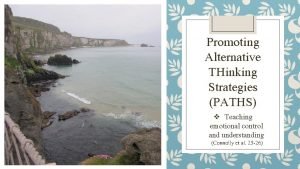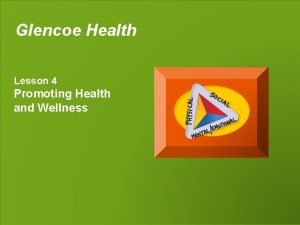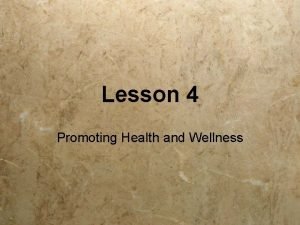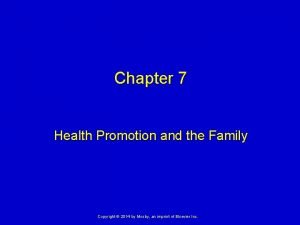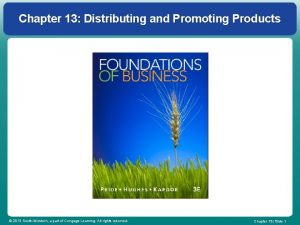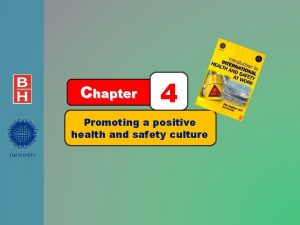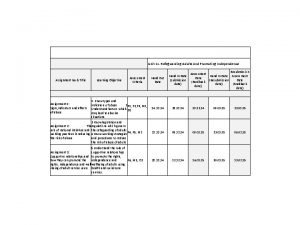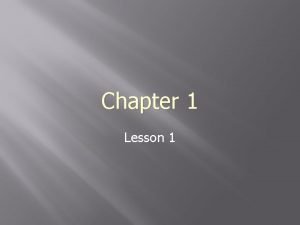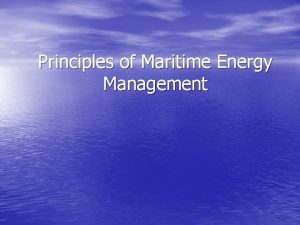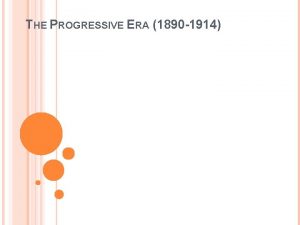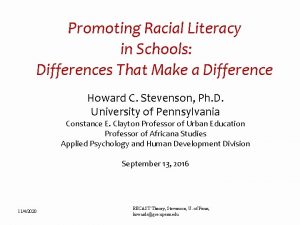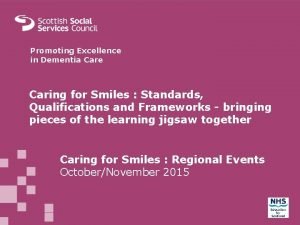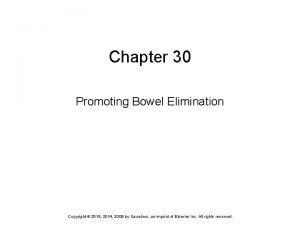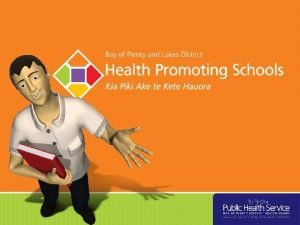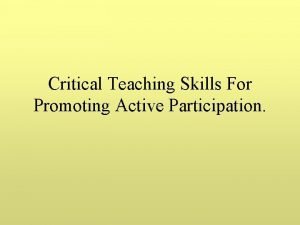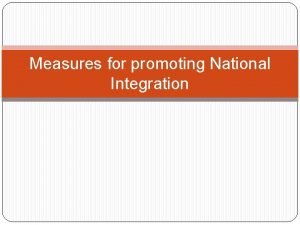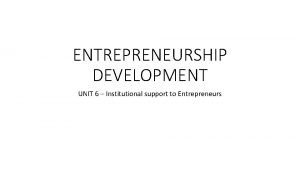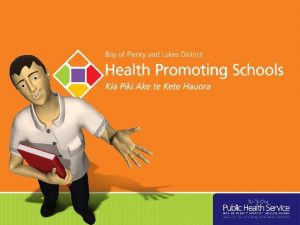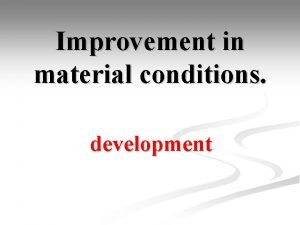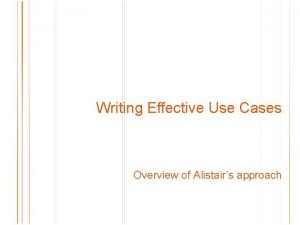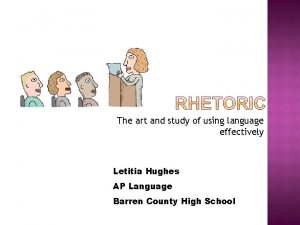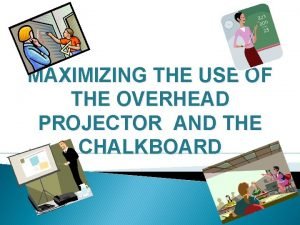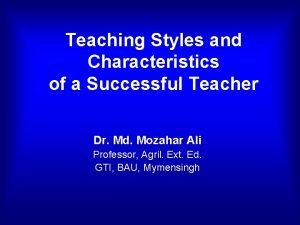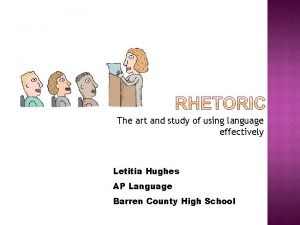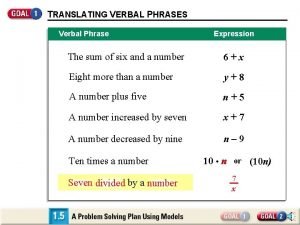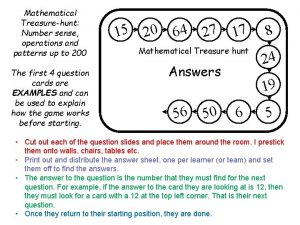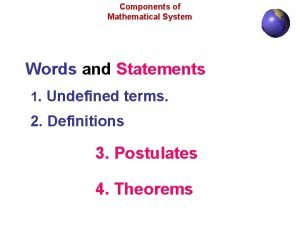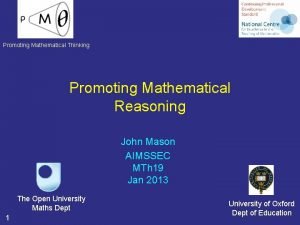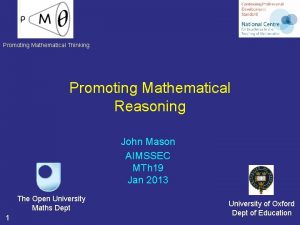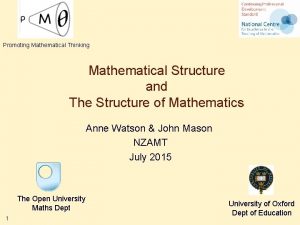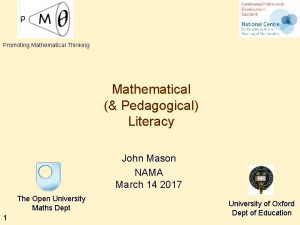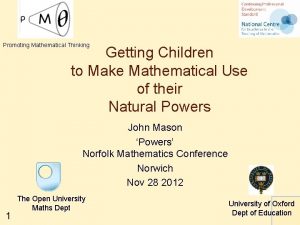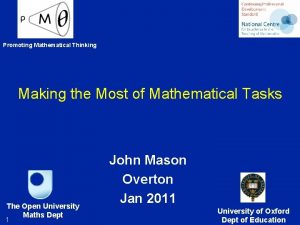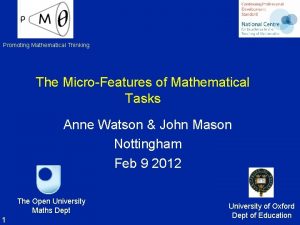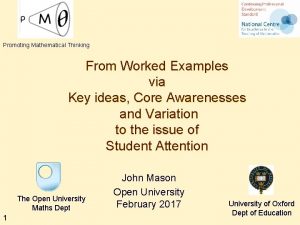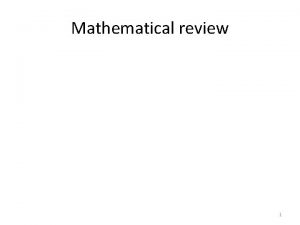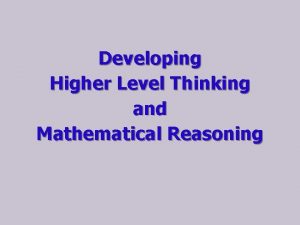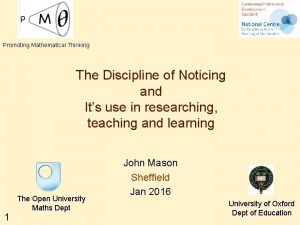Promoting Mathematical Thinking Effective Use of Examples and













































- Slides: 45

Promoting Mathematical Thinking Effective Use of Examples and Case-studies in Teaching and Learning (Mathematics) The Open University Maths Dept 1 John Mason IDEAS Calgary May 2017 University of Oxford Dept of Education

My Current Interests v v The role and nature of attention in teaching and learning mathematics Drawing on the full human psyche: – Cognition, Affect, Enaction; Attention, Will, Witness; Conscience v Developing Dual Systems Theory to the whole psyche – – v 3 S 1: automaticity S 1. 5: emotivity S 2: consideration (particularly cognitively) S 3: openness to creative energy How tools and tasks mediate between student, teacher and mathematics

Examples and Case Studies v v v 4 What do students do with examples (or case studies)? What would you like students to do with examples? What do you do with examples publicly so that students learn what it is possible to do with examples?

What do students say? v v v 5 “I seek out worked examples and model answers” “I practice and copy in order to memorise” “I skip examples when short of time” “I compare my own attempts with model answers” NO mention of mathematical objects other than worked examples!

Rhind Mathematical Papyrus problem 28 Two-thirds is to be added. One-third is to be subtracted. There remains 10. Make 1/10 of this, there becomes 1. The remainder is 9. The answer! 2/3 of this is to be added. 9 + 2/3 x 9 = 15 The total is 15. 1/3 of this is 5. Lo! 5 is that which goes out, 15 – 5 = 10 Checking! And the remainder is 10. validating 6 The doing as it occurs!

Worked Examples v v v A 4000 year old practice “Thus is it done”; “Do it like this”; … What is the student supposed to do? – Follow the sequence of acts – Distinguish structural relations and values from parameters v v Templating What does the student need from a worked example? – What to do ‘next’ – How to know what to do next 7 Chi & Bassok Renkl & Sweller Watson & Mason

Rhind Mathematical Papyrus problem 28 Two-thirds is to be added. One-third is to be subtracted. There remains 10. (1 + 2/3) (1 – 1/3)(1 + 2/3) = = = / (1 + 2/3)(1 – 1/3) / (10/9) = (9/10) The doing as it occurs! 8 Make 1/10 of this, there becomes 1. The remainder is 9.

Appreciating & Comprehending Division v v v I tell you that 10101 is divisible by 37. What is the remainder upon dividing How do you 1010137 by 37? 0 know? What is the remainder upon dividing Did you write it down How do you 1010123 by 37? for yourself? 23 know? What is the remainder upon dividing How do you 10124 by 37? 23 know? What is the remainder upon dividing How do you 0 232323 by 37? know? Make up your own similar question – What is the same and what different about your task and mine? It’s all about what you are attending to, and how you are attending to it 9 Attention is directed by what is being varied

What is Being Exemplified? v Of what is 0. 9 an example? – The decimal name for a number – The decimal name for the rational number 9/10 Ø or indeed 18/20, …, 90/100, . . . – The decimal name for 9 divided by 10 – The decimal value of the ratio of 9 : 10 – The decimal name for 90% v Of what is 0. 9 an example? – – 10 A number whose square is smaller than itself A counter-example to the conjecture that “squaring makes bigger” A number whose square is less than 1 A number specified to one decimal place

Example Construction v Please write down a decimal number between 2 and 3 2. 5 – That does not use the digit 5; Ø and another Ø and yet another – That does not use the digit 5 but does use the digit 7 and is as close to 5/2 as possible 2. 7 2. 497 2. 499… 97 2. 479 2. 499… 9799. . 11

Copper. Plate Multiplication 12

Copper Plate Multiplication (alternate) v 13 Spot the deliberate mistake!

Exercises as Examples for developing facility Varying type for deepening comprehension Varying structure Doing & Undoing for extending appreciation Varying context Complexifying & Embedding for enriching accessible example spaces 14 Learners generating own examples subject to constraints Extending, & Restricting Generalising & Abstracting

Strategies for Use with Exercises v v v v 15 Sort collection of different contexts, different variants, different parameters Characterise odd one out from three instances Put in order of anticipated challenge Do as many as you need to in order to be able to do any question of this type Construct (and do) an Easy, Hard, Peculiar; and where possible, a General task of this type Decide between appropriate and flawed solutions Describe how to recognise a task ‘of this type’; Tell someone ‘how to do a task of this type’ What are tasks like these accomplishing (narrative about place in mathematics)

Exercises What is being varied? To what effect? 16

Alternative Exercises 17

¾ and ½ What distinguishes each from the other two? What ambiguities might arise? What misconceptions or errors might surface? 18

Ratio Division v To divide $100 in the ratio of 2 : 3 2: 3 … … 2: 3 2 2 2: 3 3 3 2: 3 … 1 1 19 … 1 1 1 1 What is the same, and what different about these three approaches? … 1 1 1 1

Ratio Division & Variation What is it possible to learn from a set of exercises like this? 20 Consider the sums of the ratio parts Consider the use of full stops /decimal points When is the amswer not a whole number?

What is being varied? Is this a triangle? What can be done with these exercises? 21

Exploring Ratio Division v v v 22 The number 15 has been divided in some ratio and the parts are both integers. In how many different ways can this be done? Generalise! If some number has been divided in the ratio 3 : 2, and one of the parts is 12, what could the other part be? Generalise! If some number has been divided in the ratio 5 : 2, and the difference in the parts is 6, what could the original number have been? Generalise!

Initial Playfulness v Luis baked muffins. He sold muffins were left? of them. How many – What kinds of numbers could be hidden? – What relationships must there be between the number baked and the number sold? – How might the number sold be described? – What numbers would be possible if 10 was the answer? – If you knew that 8 were sold and 12 left over, what must the first number be? 23

Problem Solving via Covering-Up 24 v If Anne gives John 5 of her marbles, and then John gives Martina 2 of his marbles, Anne will have one more marble than Martina and the same number as John. How many more marbles has Martina than John at the start? v If Anne gives John 5 of her marbles, and then John gives Martina 2 of his marbles, Anne will have one more marbles than Martina and one less than John. How many more marbles has Martina than John at the start? v If Anne, John and Martina give each other some marbles of their marbles. …

Multi-Level Initiating of Tasks v In how many different ways can a unit fraction be expressed as the difference of two unit fractions? v Notice that v 25 Notice that Anticipating & Conjecturing

The Calleja Spiral v v Imagine a cartesian grid based on integers Imagine the following points [0, 1] [2, 0] [0, -3] [-4, 0] v v 26 [0, 5] [6, 0] [0, -7] [-8, 0] … [0, . . . ] [. . . , 0] Now join them in sequence by straight lines Say What You See to a neighbour

What more can you ‘see’? v v v v Almost parallel lines Right-angled triangles Almost trapezia Lengths Slopes Areas Sequences of – lengths, areas, slopes, … v v v 27 Sums of Sequences (series) Circles Almost right-angled Triangles

28

29

Relevant Curriculum Topics v Area of triangles – Triangular numbers (formula) – Using triangles to form other figures v v v v 30 Slopes and Equations of lines Conditions for lines being parallel Lengths (Pythagoras; vertex coordinates) Area of Quadrilaterals Expressing nth term of a sequence Expressing nth sum of a sequence Limits of sequences Constructing a line through a point and the virtual intersection of two lines

Example Spaces & Variation v v v 31 Populating Generativity Connnectedness Generality Conventional (canonical) Personal v Intended Object of Learning (IOL) v Enacted Object of Learning (EOL) v Lived Object of Learning (LOL) v Invariant or Varying

Progression & Development v v v DTR (do, talk, record) MGA (manipulating, getting-a-sense-of, articulting) EIS (enactive, iconic, symbolic: Bruner) – (weaning off material objects) v v 32 PES (Enriching Personal Example Space) LGE (Learner Generated Examples) Re-construction when needed Communicate effectively with others

Inner, Outer & Mediating Aspects of Tasks v Outer – What task actually initiates explicitly v Inner – – v What mathematical concepts underpinned What mathematical themes encountered What mathematical powers invoked What personal propensities brought to awareness Mediating – Between teacher and Student – Between Student and Mathematics (concepts; inner aspects) v Activity – Enacted & lived objects of learning Object of Learning Resources Current State 33 Tasks

Powers & Themes Are students being encouraged to use their own powers? Powers or are their powers being usurped by textbook, worksheets and … ? Imagining & Expressing Specialising & Generalising Conjecturing & Convincing (Re)-Presenting in different modes Organising & Characterising Themes Doing & Undoing Invariance in the midst of change Freedom & Constraint Restricting & Extending Exchanging 34

‘Problems’ v Krutetskii Having been subtracting numbers for three lessons, children are then asked: – If I have 13 sweets and eat 8 of them, how many do I have left over? What is being attended to and how? v A question has arisen in a discussion about journeys to and from school: – Mel and Molly walk home together but Molly has an extra bit to walk after they get to Mel’s house; it takes Molly 13 minutes to walk home and Mel 8 minutes. For how many minutes is Molly walking on her own? What is being attended to and how? v 35 A question about numbers: – If two numbers add to make 13, and one of them is 8, how can we find the other? What is being attended to and how?

Example Types v Procedures – Worked examples v v Case studies Concept Examples – Instances v Directing attention to – – 36 Concept boundaries Generalisation Uncommon Example, non-example & counter-example Zodik & Zaslavsky

Exercises for developing facility Varying type for deepening comprehension Varying structure Doing & Undoing for extending appreciation Varying context Complexifying & Embedding for enriching accessible example spaces 37 Learners generating own examples subject to constraints Extending, & Restricting Generalising & Abstracting

Mathematical Thinking v v v How might you describe the mathematical thinking you have done so far today? How could you incorporate that into students’ learning? What have you been attending to: – – – 38 Results? Actions? Effectiveness of actions? Where effective actions came from or how they arose? What you could make use of in the future?

Reflection Strategies v v v 39 What technical terms involved? What concepts called upon? What mathematical themes encountered? What mathematical powers used (and developed)? What links or associations with other mathematical topics or techniques?

Reflection and the Human Psyche v v v v 40 What struck you during this session? What for you were the main points (cognition)? What were the dominant emotions evoked? (affect)? What actions might you want to pursue further? (enaction) What initiative might you take (will)? What might you try to look out for in the near future (witness) What might you pay special attention to in the near future (attention)? What aspects of teaching need specific care (conscience)?

Making Use of the Whole Psyche v Assenting & Asserting Awareness (cognition) Imagery Will Emotions (affect) Body (enaction) 41 Habits Practices

Practising Practices v Principles (Tom Francome & Dave Hewitt ATM 2017) – – – v Exploration to gain further insight Learners make significant choices Opportunity to notice and become familiar with relationships Opportunity to justify and prove Adaptable & extendable Conjectures – A practice is a sequence of actions often repeated – To practise is to use a practice effectively (professionally) – To develop a practice is to rehearse actions in multiple contexts so as to appreciate and to comprehend those actions and their significance. 42

Reflection as Self-Explanation v v 43 What struck you during this session? What for you were the main points (cognition)? What were the dominant emotions evoked? (affect)? What actions might you want to pursue further? (Awareness)

Frameworks Enactive – Iconic – Symbolic Doing – Talking – Recording See – Experience – Master Concrete – Pictorial– Symbolic 44

What Can Teachers Do? v It is not the task that is rich … but the way the task is used v v Teachers can guide and direct learner attention What are teachers attending to? … powers … Themes … heuristics … The nature of their own attention 45

To Follow Up v v v v 46 www. pmtheta. com john. mason@open. ac. uk Thinking Mathematically (new edition 2010) Developing Thinking in Algebra (Sage) Designing & Using Mathematical Tasks (Tarquin) Questions and Prompts: primary (ATM) Mathematics as a Constructive Activity (with Anne Watson)
 Promoting alternative thinking strategies
Promoting alternative thinking strategies Mathematical vs non mathematical economics
Mathematical vs non mathematical economics Positive thinking vs negative thinking examples
Positive thinking vs negative thinking examples Promote service arrange decide
Promote service arrange decide Chapter 1 lesson 4 promoting health and wellness
Chapter 1 lesson 4 promoting health and wellness Lesson 4 promoting health and wellness
Lesson 4 promoting health and wellness Lesson 4 promoting health and wellness
Lesson 4 promoting health and wellness Chapter 7 promoting health and wellness
Chapter 7 promoting health and wellness Chapter 13 distributing and promoting products
Chapter 13 distributing and promoting products Promoting services and educating customers
Promoting services and educating customers Promoting a positive health and safety culture
Promoting a positive health and safety culture Unit 11 safeguarding adults and promoting independence
Unit 11 safeguarding adults and promoting independence Chapter 1 lesson 4 promoting health and wellness
Chapter 1 lesson 4 promoting health and wellness Maritime energy conservation
Maritime energy conservation Thinking about your own thinking
Thinking about your own thinking Analytic vs holistic thinking example
Analytic vs holistic thinking example Perbedaan critical thinking dan creative thinking
Perbedaan critical thinking dan creative thinking Thinking about you thinking about me
Thinking about you thinking about me When was the progressive era? *
When was the progressive era? * Promoting family earthquake preparedness
Promoting family earthquake preparedness Promoting racial literacy in schools
Promoting racial literacy in schools Methods of promoting intrapreneurship leaving cert
Methods of promoting intrapreneurship leaving cert Keeping an infant safe and well section 7-3
Keeping an infant safe and well section 7-3 Promoting excellence in dementia care
Promoting excellence in dementia care Deontological ethics meaning
Deontological ethics meaning Promoting bowel elimination
Promoting bowel elimination Health promoting schools model
Health promoting schools model Active participation strategies
Active participation strategies Promoting national integration
Promoting national integration Institutions supporting entrepreneurs
Institutions supporting entrepreneurs Health promoting school
Health promoting school Japan's principal asset in promoting development is
Japan's principal asset in promoting development is Writing effective use cases
Writing effective use cases The art of using language effectively
The art of using language effectively Use of overhead projector
Use of overhead projector Demonstrator or coach style
Demonstrator or coach style The art of using language effectively and persuasively
The art of using language effectively and persuasively How to use critical thinking
How to use critical thinking Critical thinking in everyday life
Critical thinking in everyday life Ineffective praise
Ineffective praise Design capacity and effective capacity examples
Design capacity and effective capacity examples Yesterday
Yesterday Verbal phrases to mathematical phrases examples
Verbal phrases to mathematical phrases examples How to make mathematical treasure hunt
How to make mathematical treasure hunt What are the components of a mathematical system
What are the components of a mathematical system Mathematical modeling of electrical systems
Mathematical modeling of electrical systems
